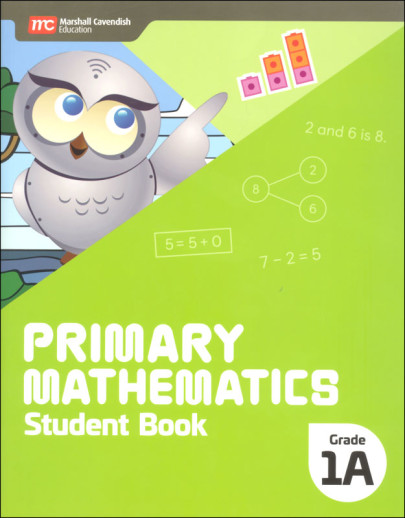We use cookies to make your experience better. To comply with the new e-Privacy directive, we need to ask for your consent to set the cookies. Learn more.
Primary Mathematics Student Book 1A (Revised edition - 2022 Edition)
The colorful and engaging Student Books are consumable. The Grade 1 level has a winsome owl mascot. This owl critter shows up on all the products for that grade level, and the inside pages include this critter as well as others.
Although reminiscent of the semester-based textbooks of previous Primary Math editions, these are expanded in terms of instruction as well as included practice exercises. They are not designed, however, to stand alone but to be a tool in the hand of the teacher (parent). Comprehensive instruction is the result of the instructional sequences provided by the teacher coupled with directed questions.
The general appearance of these full-size (8.5"x 11") books is uncluttered, providing room for student work with just enough color and appropriate light-hearted graphics. Pages are perforated. Chapters are initiated with full-page, full-color real-world illustrated story situations. Lessons are “opened" with half-page illustrated “stories."
Instruction in the Student Book follows an Opener – Learn – Practice pattern through the daily lessons and a Recall – Instructional Sections – Performance Task – STEAM Project – Chapter Practice – Chapter Test organization through each chapter. Periodic Think! exercises focus on critical thinking skills and problem solving. The Singapore math basics are obvious throughout the course: start with the concrete, move to pictorial in the Student Book, and morph into abstract concepts.
The Practice on Your Own pages in the Student Book provide practice at the end of each lesson, but these are just the tip of the iceberg in terms of practice and homework options available. In the Mastery and Beyond book (for K-5), after each Section (collection of lessons), there is an exercise assignment available. These exercises are cumulative over several lessons. In the Additional Practice book (K-6), differentiated instructional options for each lesson include correlated on-level practice exercises. For students needing additional instruction, there is also a Reteach Book (K-5), and for those students who need additional challenge, an Extension Book (K-6) is available. These last two resources are only available as digital versions.
The Student Book is the consumable textbook of the program. Chapters and daily lessons are based on the Readiness-Engagement-Mastery model of learning used in Singapore classrooms. In the Readiness phase, students make connections to previously learned concepts and skills to be sure they have the base knowledge to succeed with learning goals. In the Engagement phase, students learn by doing and construct new knowledge through engaging activities and guided inquiry. In the Mastery phase, students gain fluency, confidence, and deeper conceptual understanding through practice and problem solving.
Note: Two books (A and B) for each grade correspond to the two halves of the school year. Answer key in Teacher's Guide and Home Instructor's Guide.
Concepts covered include: Group objects and numbers up to 120 in groups of ten and ones. Use cardinal numbers up to 120. Use number bonds to represent number combinations and to add and subtract. Count within 120. Count by 1s and 10s forward and backward to 100. Compare and order whole numbers to 100 (using the terms same, more, fewer, greater than, less than, equal to, greatest, and least. Make groups of 10 and count on to tell the number. Use base-ten blocks and place-value charts to represent numbers to 120. Write numbers to 120 in standard and word forms. Partition shapes into two to four equal shares, describing them as halves, fourths, and quarters. Identify and relate coin values (penny, nickel, dime, quarter). Count and make simple coin combinations. Add and subtract within 20, using appropriate models, numbers, and symbols. Practice addition and subtraction within 10. Add and subtract up to two 2-digit numbers with and without regrouping. Add the same number to find the total number of items in equal groups. Use mental math strategies to add and subtract. Identify, describe, and extend two- and three-dimensional shape patterns. Use the Associative and Commutative Properties of addition. Understand the relationships between the numbers in fact families. Identify and describe two-dimensional shapes in different sizes and orientations. Sort and classify two-dimensional shapes based on attributes. Identify two-dimensional shapes and three-dimensional shapes. Compose and decompose three-dimensional shapes. Compare the lengths of two objects by comparing to a third length. Tell time to the hour and half-hour on analog and digital clocks. Sort and classify geometric shapes. Collect and organize data in different ways. Represent and interpret data in picture graphs and tally charts. Build skills in addition, subtraction, and measurement through problem solving. Further investigate mathematical ideas by completing critical thinking skills activities. Connect addition and multiplication. Learn how place-value concepts apply to regrouping in addition and subtraction. Use number bonds to represent number combinations. Consult or download the complete Scope and Sequence for a full report of covered topics and concepts.

















Colorful inside, just enough practice problems, and engaging pictures and activities. We love the revised version!
She loved her kindergarten "fox math" and can't wait to begin "owl math." We add in a puppet for additional fun!
We finished the K program and loved it so time to move on!
for school curriculum